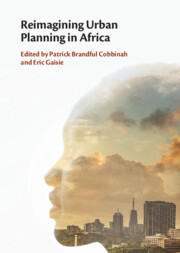Book contents
- Reimagining Urban Planning in Africa
- Reimagining Urban Planning in Africa
- Copyright page
- Contents
- Contributors
- Foreword
- Preface
- Acknowledgements
- Abbreviations
- Part I Understanding Sustainable Urban Planning in Africa
- 1 Reimagining African Cities
- 2 Annals of Urban Planning in Africa
- 3 New Cities in Africa and the Reimagination of Urban Planning
- 4 Informal Settlements and Pro-poor Urban Planning in African Cities
- 5 Urban Planning and Sustainable Land Governance in Africa
- 6 Urban Planning and Climate Change Action in Africa
- Part II Case Studies on Urban Planning in African Countries
- Part III Sustainable Urban Planning in Africa
- Index
- References
2 - Annals of Urban Planning in Africa
from Part I - Understanding Sustainable Urban Planning in Africa
Published online by Cambridge University Press: 07 December 2023
- Reimagining Urban Planning in Africa
- Reimagining Urban Planning in Africa
- Copyright page
- Contents
- Contributors
- Foreword
- Preface
- Acknowledgements
- Abbreviations
- Part I Understanding Sustainable Urban Planning in Africa
- 1 Reimagining African Cities
- 2 Annals of Urban Planning in Africa
- 3 New Cities in Africa and the Reimagination of Urban Planning
- 4 Informal Settlements and Pro-poor Urban Planning in African Cities
- 5 Urban Planning and Sustainable Land Governance in Africa
- 6 Urban Planning and Climate Change Action in Africa
- Part II Case Studies on Urban Planning in African Countries
- Part III Sustainable Urban Planning in Africa
- Index
- References
Summary
Urban planning in Africa is linked to elements of colonisation, production of informal spaces and socio-spatial segregation. Discussing it often provokes considerable emotions. How do urban planning histories fit into current planning practice? What constitutes reimagined urban planning in African cities? And how do current urban planning practices promote or limit urban planning reimagination and sustainable urban development? This chapter addresses these questions by highlighting the importance of planning histories in framing current planning theory and the production of urban spaces in Africa as well as their implication for sustainable urban development. The chapter shows how pre-colonial, colonial and post-colonial planning narratives continue to dominate and frame twenty-first-century planning practice across African cities. Drawing from published literature, policy documents and international reports, the chapter advocates for a participatory narrative in deconstructing planning,and promoting inclusiveness and spatial integration toward a reimagination of urban planning in Africa.
- Type
- Chapter
- Information
- Reimagining Urban Planning in Africa , pp. 18 - 35Publisher: Cambridge University PressPrint publication year: 2023



